Effect of Temperature on S32750 Duplex Steel Welded Joint Impact Toughness
Abstract
1. Introduction
2. Materials and Methods
2.1. Base Material
2.2. Welding
2.3. Microstructure and Fractography
2.4. Impact Toughness Testing
3. Results
3.1. Microstructure
3.2. Charpy Testing
3.3. Fractography
4. Discussion
5. Conclusions
- The base material had a very high toughness at all the tested temperatures, from 297 J (+20 °C) to 82 J (−80 °C). Contrary to this, the total impact energy was significantly affected by WM and HAZ heterogeneity since it reduced from 229.3 (WM at +20 °C) to 26.5 J (WM at −80 °C) and from 87.7 (HAZ at +20 °C) to 17.6 J (HAZ at −80 °C).
- The transition temperature for BM was very low at −110 °C, but it was significantly higher for the WM and HAZ at −80 °C and −50 °C, respectively, indicating that welded joints made of S32750 duplex steel can operate safely only at temperatures above −50 °C.
- The distribution of energies was favourable since crack propagation was significantly higher than initiation energy.
Author Contributions
Funding
Institutional Review Board Statement
Informed Consent Statement
Data Availability Statement
Acknowledgments
Conflicts of Interest
References
- Charpy, G. Note sur l’essai des metaux a la flexion par choc de barreaux entailles, Association internationale pour l’essai des materiaux—Budapest. Int. J. Fract. 1901, 25, 287–305. [Google Scholar] [CrossRef]
- Tóth, L.; Rossmanith, H.-P.; Siewert, T.A. Historical background and development of the Charpy test. Eur. Struct. Integr. Soc. 2002, 30, 3–19. [Google Scholar] [CrossRef]
- Grabulov, V.; Burzić, Z.; Momčilović, D. Significance of Mechanical Testing for Structural Integrity; IFMASS 9: Belgrade, Serbia, 2008. [Google Scholar]
- Viehrig, H.-W.; Boehmert, J.; Dzuga, J. Use of instrumented Charpy impact tests for the determination of fracture toughness values. Eur. Struct. Integr. Soc. 2002, 30, 245–252. [Google Scholar] [CrossRef]
- Schmitt, W.; Varfolomeyev, I.; Böhme, W. Modelling of the Charpy test as a basis for toughness evaluation. Eur. Struct. Integr. Soc. 2002, 30, 45–56. [Google Scholar] [CrossRef]
- Wallin, K.; Nevasmaa, P.; Planman, T.; Valo, M. Evolution of the Charpy-V test from a quality control test to a materials evaluation tool for structural integrity assessment. Eur. Struct. Integr. Soc. 2002, 30, 57–68. [Google Scholar]
- Jovanovic, M.; Camagic, I.; Sedmak, S.; Zivkovic, P.; Sedmak, A. Crack initiation and propagation resistance of HSLA steel welded joint constituents. Struct. Integr. Life 2020, 20, 11–14. [Google Scholar]
- Jovanovic, M.; Camagic, I.; Sedmak, S.; Sedmak, A.; Burzic, Z. The Effect of Material Heterogeneity and Temperature on Impact Toughness and Fracture Resistance of SA-387 Gr. 91 Welded Joints. Materials 2022, 15, 1854. [Google Scholar] [CrossRef]
- Prokic-Cvetkovic, R.; Popovic, O.; Radovic, L.; Sedmak, A.; Cvetkovic, I. Fracture Behavior of AlMg4.5Mn Weld Metal at Different Temperatures under Impact Loading. Sustainability 2023, 15, 1550. [Google Scholar] [CrossRef]
- Tvergaard, V.; Needleman, A. 3D Charpy specimen analyses for welds. Eur. Struct. Integr. Soc. 2002, 30, 437–444. [Google Scholar] [CrossRef]
- Čamagić, I.; Jović, S.; Radojković, M.; Sedmak, S.; Sedmak, A.; Burzić, Z.; Delamarian, C. Influence of Temperature and Exploitation Period on the Behaviour of a Welded Joint Subjected to Impact Loading. Struc. Integr. Life 2016, 16, 179–185. [Google Scholar]
- Jovanović, M.; Čamagić, I.; Sedmak, A.; Burzić, Z.; Sedmak, S.; Živković, P. Analysis of SA 387 Gr. 91 welded joints crack resistance under static and impact load. Procedia Struct. Integr. 2021, 31, 38–44. [Google Scholar] [CrossRef]
- Gennari, C.; Pezzato, L.; Tarabotti, G.; Zambon, A.; Di Schino, A.; Calliari, I. Influence of Electropulsing Treatments on Mechanical Properties of UNS S32750 Duplex Stainless Steel. Materials 2020, 13, 1613. [Google Scholar] [CrossRef] [PubMed]
- Pezzato, L.; Calliari, I. Advances in Duplex Stainless Steels. Materials 2022, 15, 7132. [Google Scholar] [CrossRef] [PubMed]
- Barella, S.; Ciuffini, A.F.; Gruttadauria, A.; Mapelli, C.; Mombelli, D.; Longaretti, E. Corrosion and Oxidation Behaviour of a Fe-Al-Mn-C Duplex Alloy. Materials 2019, 12, 2572. [Google Scholar] [CrossRef]
- Biserova-Tahchieva, A.; Cabrera, J.M.; Llorca-Isern, N. Study of the Thermochemical Surface Treatment Effect on the Phase Precipitation and Degradation Behaviour of DSS and SDSS. Materials 2020, 13, 165. [Google Scholar] [CrossRef]
- Carla Gabriela Silva Leite 1, Eli Jorge da Cruz Junior 2, Mattia Lago 3, Andrea Zambon 3, Irene Calliari and Vicente Afonso Ventrella 1, Nd: YAG Pulsed Laser Dissimilar Welding of UNS S32750 Duplex with 316L Austenitic Stainless Steel. Materials 2019, 12, 2906. [CrossRef]
- Rodriguez, B.R.; Miranda, A.; Gonzalez, D.; Praga, R.; Hurtado, E. Maintenance of the Austenite/Ferrite Ratio Balance in GTAW DSS Joints Through Process Parameters Optimization. Materials 2020, 13, 780. [Google Scholar] [CrossRef]
- Gennari, C.; Pezzato, L.; Simonetto, E.; Gobbo, R.; Forzan, M.; Calliari, I. Investigation of Electroplastic Effect on Four Grades of Duplex Stainless Steels. Materials 2019, 12, 1911. [Google Scholar] [CrossRef]
- Cojocaru, E.M.; Nocivin, A.; Răducanu, D.; Angelescu, M.L.; Cinca, I.; Balkan, I.V.; Serban, N.; Cojocaru, V.D. Microstructure Evolution during Hot Deformation of UNS S32750 Super-Duplex Stainless Steel Alloy. Materials 2021, 14, 3916. [Google Scholar] [CrossRef]
- Zhao, J.; Shi, Y.; Guo, S.; Zhu, M. Micromechanical Observation and Numerical Simulation for Local Deformation Evolution of Duplex Stainless Steel. Materials 2022, 15, 8076. [Google Scholar] [CrossRef]
- Krawczyk, R.; Słania, J.; Golanski, G.; Pfeifer, T. Mechanical Properties and Microstructure of Austenite—Ferrite Duplex Stainless Steel Hybrid (Laser + GMAW) and SAW Welded Joint. Materials 2023, 16, 2909. [Google Scholar] [CrossRef] [PubMed]
- Abdo, H.S.; Seikh, A.H. Mechanical Properties and Microstructural Characterization of Laser Welded S32520 Duplex Stainless Steel. Materials 2021, 14, 5532. [Google Scholar] [CrossRef]
- Perković, S.; Radaković, Z.; Burzić, Z.; Sedmak, S.; Sedmak, A. Stress concentration effects on toughness value of duplex steel S32750, Struct. Integr. Life 2023, 23, 3–7. [Google Scholar]
- DIN EN 12072; Welding Consumables—Wire Electrodes, Wires and Rods for Arc Welding of Stainless and Heat-Resisting Steels—Classification. DIN: Berlin, Germany, 2000.
- Stauffer, A.C.; Koss, D.A.; McKirgan, J.B. Microstructural banding and failure of a stainless steel. Met. Mater. Trans. A 2004, 35, 1317–1324. [Google Scholar] [CrossRef]
- Miranda-Pérez, A.F.; Rodríguez-Vargas, B.R.; Calliari, I.; Pezzato, L. Corrosion Resistance of GMAW Duplex Stainless Steels Welds. Materials 2023, 16, 1847. [Google Scholar] [CrossRef] [PubMed]
- Li, J.; Shen, W.; Lin, P.; Wang, F.; Yang, Z. Effect of Solution Treatment Temperature on Microstructural Evolution, Precipitation Behavior, and Comprehensive Properties in UNS S32750 Super Duplex Stainless Steel. Metals 2020, 10, 1481. [Google Scholar] [CrossRef]
- Lopez, J.M.S.; Alvarado, M.I.; Hernandez, H.V.; Quiroz, J.T.P.; Olmos, L. Failure of Stainless Steel Welds Due to Microstructural Damage Prevented by In Situ Metallography. Soldag. Inspeção. 2016, 21, 137–145. [Google Scholar] [CrossRef]
- SRPS EN ISO 148-1:2017; Metallic Materials—Charpy Pendulum Impact Test—Part 1: Test Method (ISO 148-1:2016). ISO: Geneva, Switzerland, 2019.
- SRPS EN ISO 9016:2013; Destructive Tests on Welds in Metallic Materials—Impact Tests—Test Specimen Location, Notch Orientation and Examination (ISO 9016:2012). ISO: Geneva, Switzerland, 2013.
- SRPS EN ISO 14556:2020; Metallic Materials—Charpy V-Notch Pendulum Impact Test—Instrumented Test Method (ISO/FDIS 14556:2023). ISO: Geneva, Switzerland, 2023.
- Pilhagen, J.; Sandstrom, R. Delaminations by Cleavage Cracking in Duplex Stainless Steels at Sub-Zero Temperatures. Met. Mat Trans. A 2014, 45, 4192. [Google Scholar] [CrossRef]


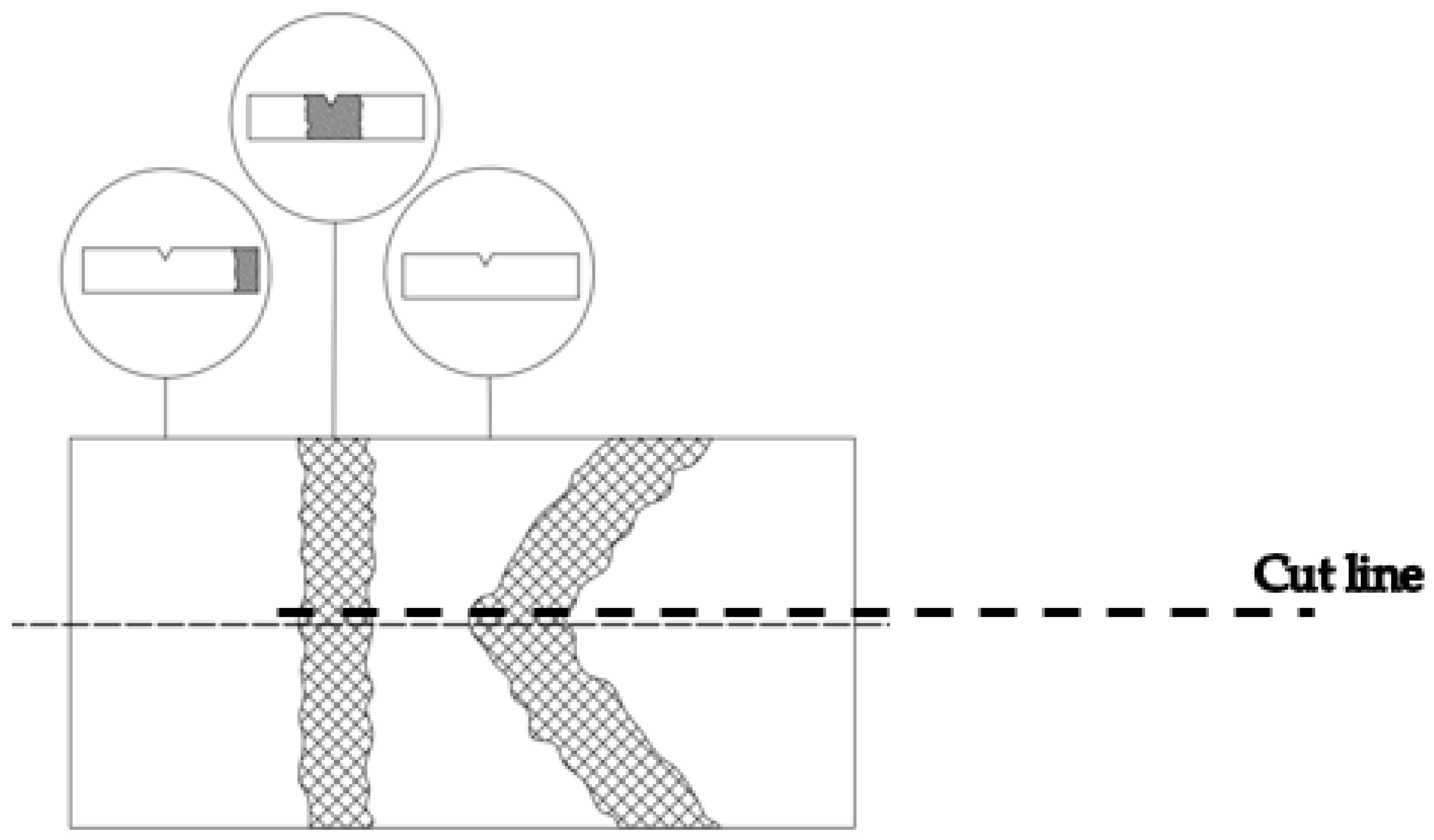
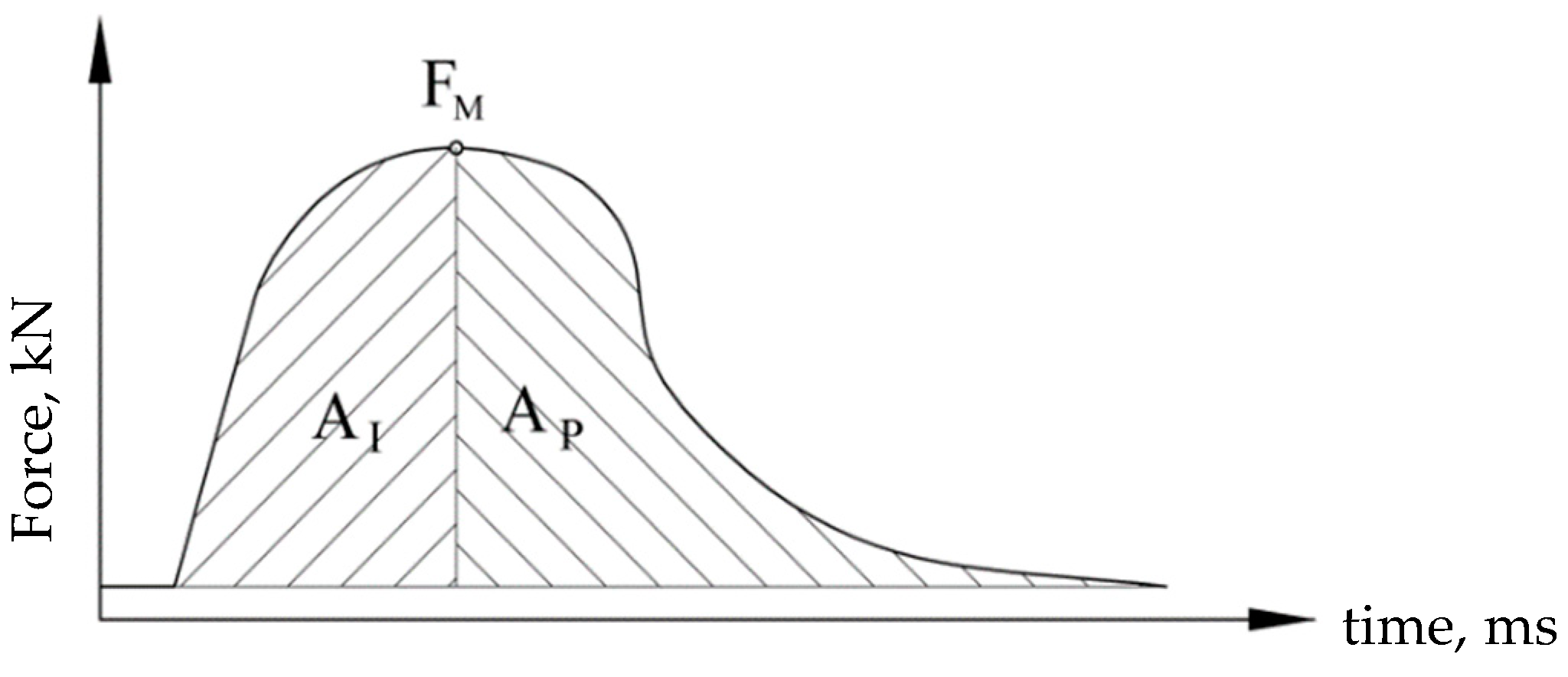



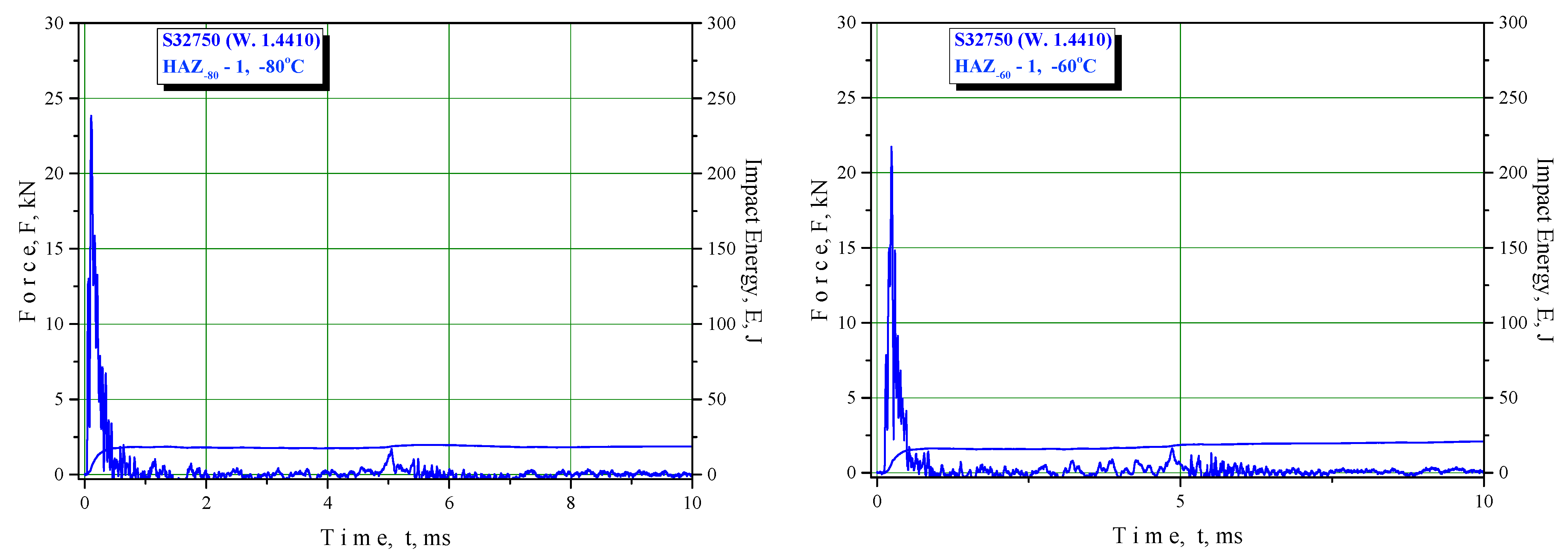

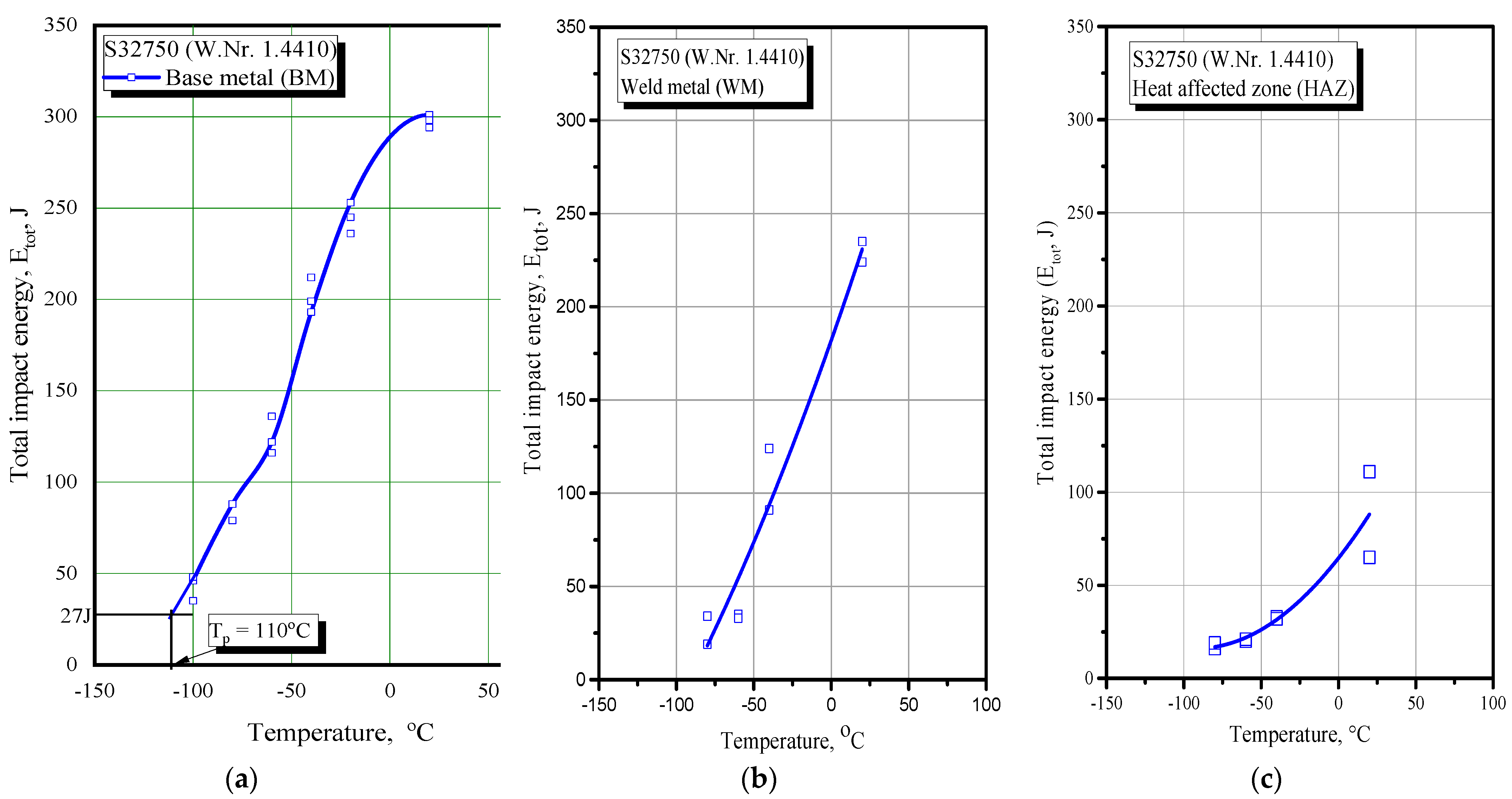

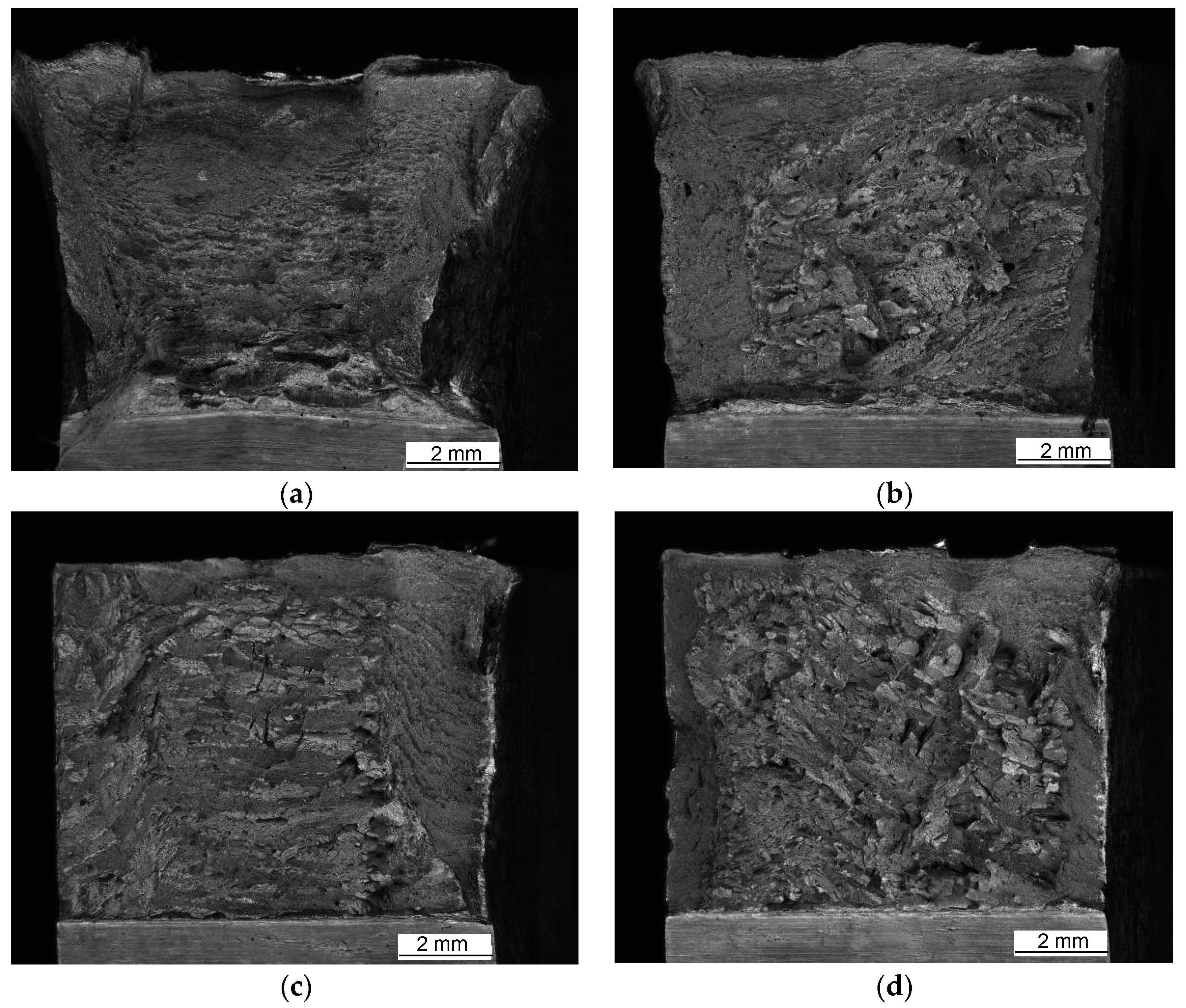
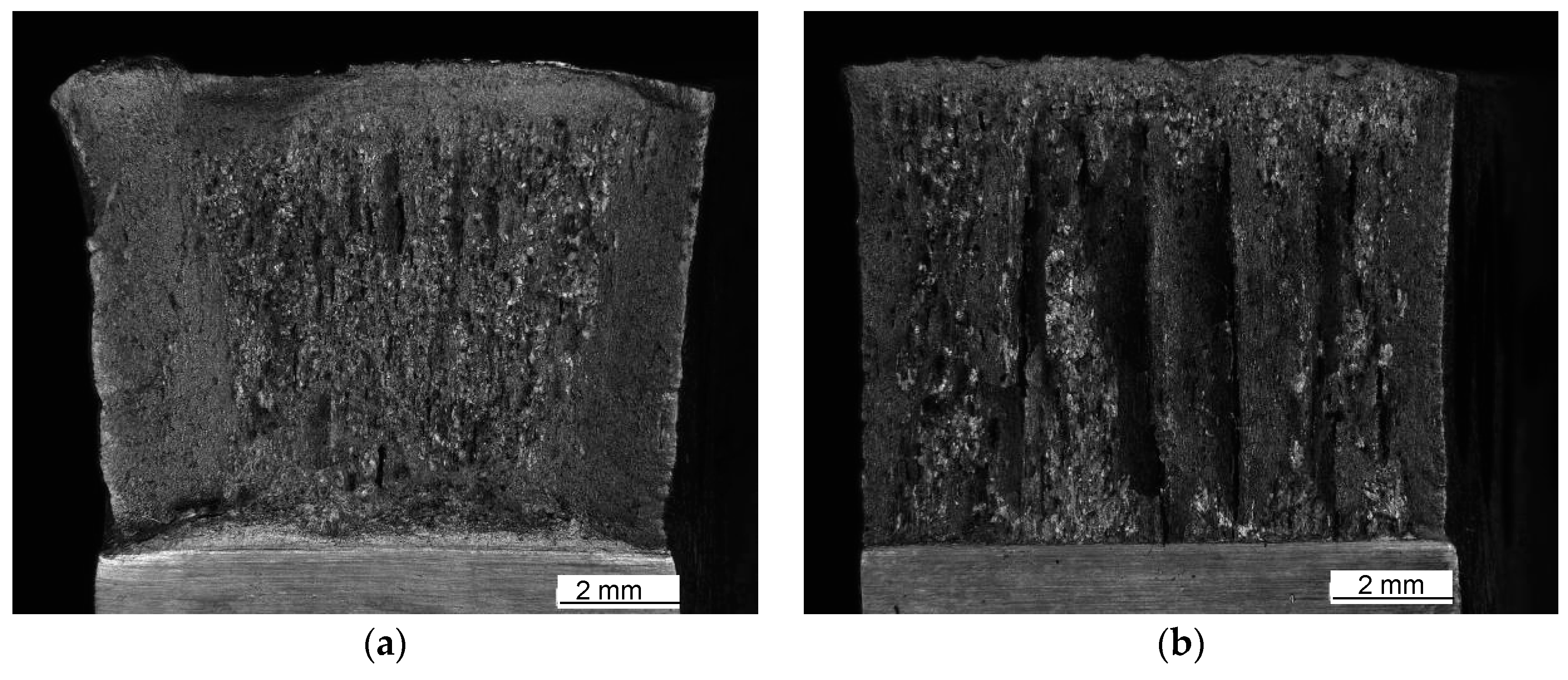
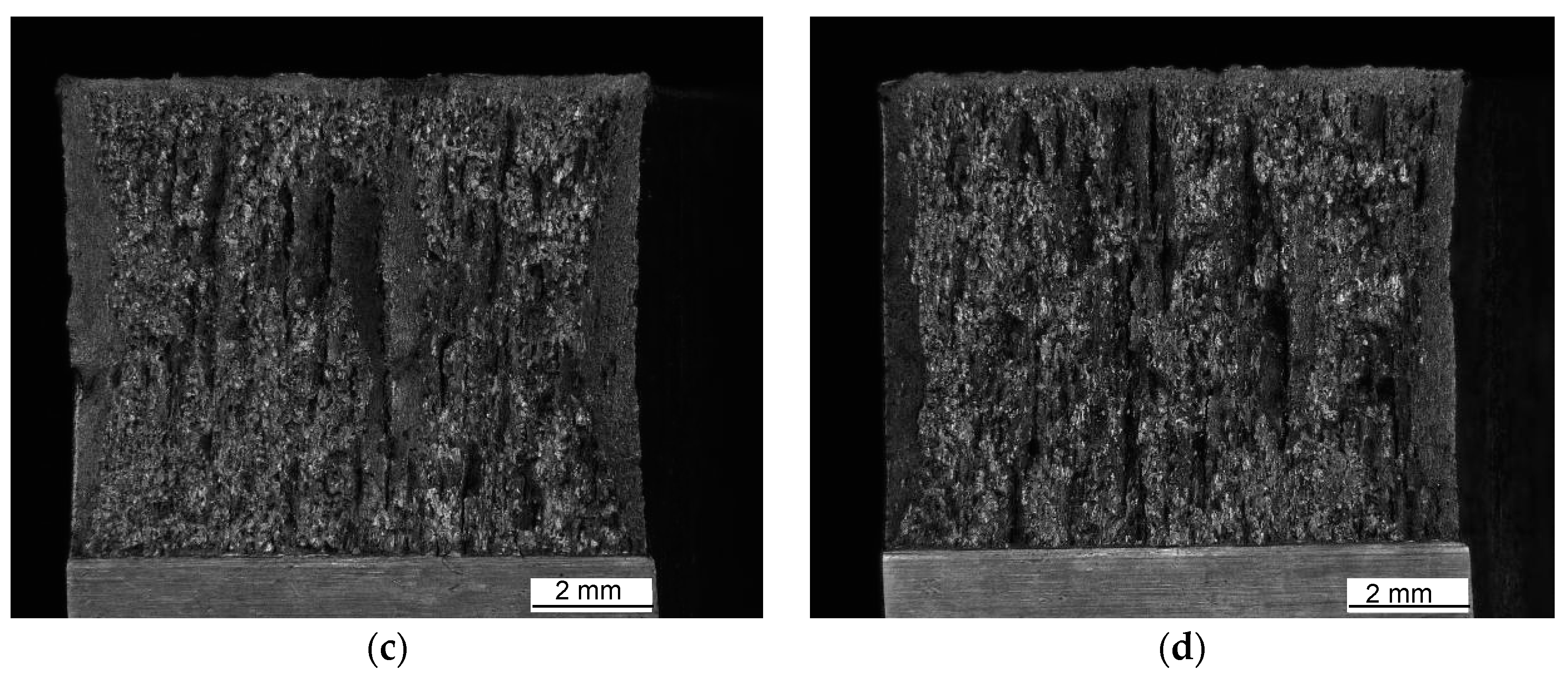
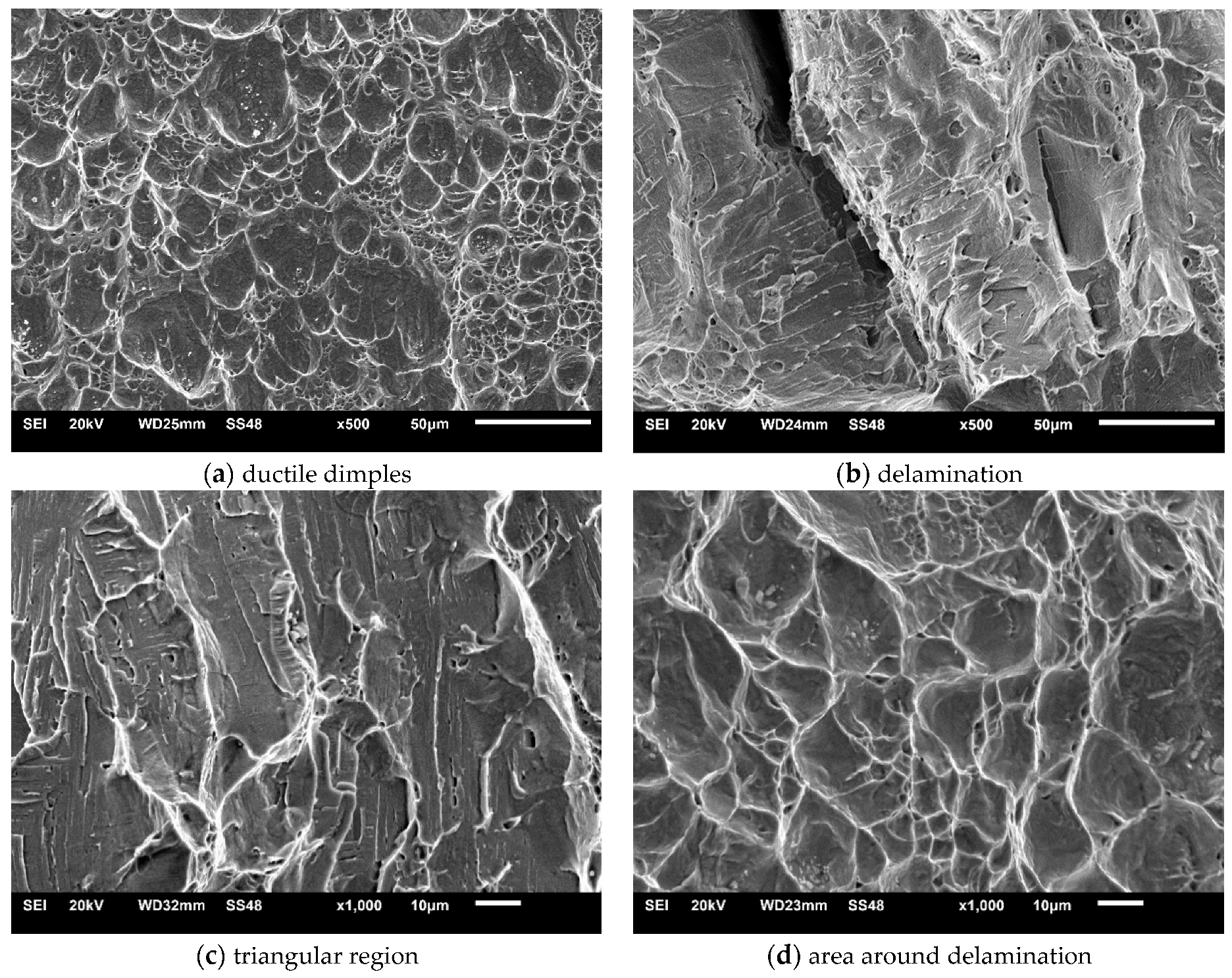

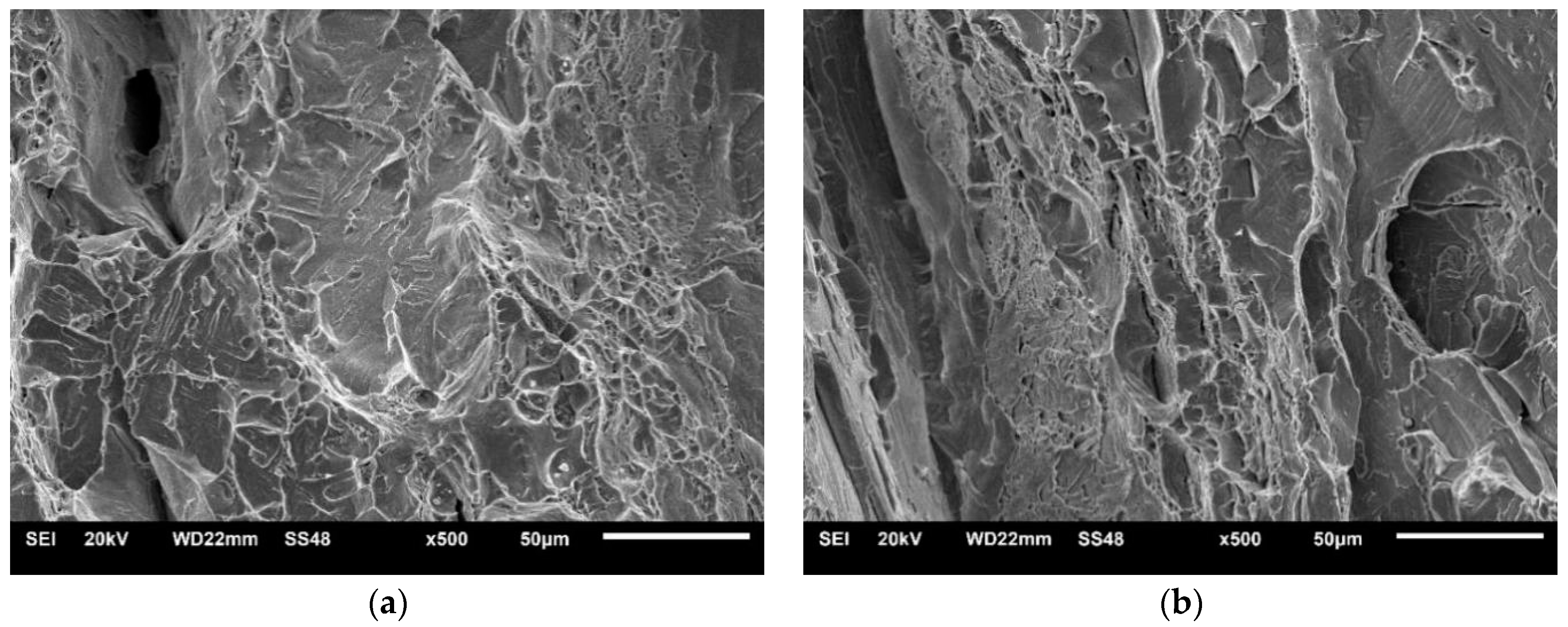
| C | Si | Mn | S | P | Cr | Ni | Cu | Al | Mo | V | Ti | N | Co |
|---|---|---|---|---|---|---|---|---|---|---|---|---|---|
| 0.02 | 0.49 | 0.88 | 0.0003 | 0.024 | 25.3 | 6.85 | 0.1 | 0.008 | 3.6 | 0.044 | 0.005 | 0.27 | 0.1 |
| Yield Stress Rp0.2, MPa | Tensile Strength Rm, MPa | Elongation at Failure A5, % | Impact Toughness KV at 20 °C, J |
|---|---|---|---|
| 584 | 855 | 32 | 297 |
| C | Si | Mn | Cr | Ni | Mo | N |
|---|---|---|---|---|---|---|
| <0.03 | 0.6 | 1.7 | 22.5 | 9.0 | 3.0 | 0.13 |
| Yield Stress Rp0.2, MPa | Tensile Strength Rm, MPa | Elongation at Failure A5, % | Impact Toughness KV at 20 °C, J |
|---|---|---|---|
| >510 | 680–890 | 20 | >47 |
| Upper Side | Lower Side | ||||||
|---|---|---|---|---|---|---|---|
| Pass | Current (A) | Voltage (V) | Duration (min) | Pass | Current (A) | Voltage (V) | Duration (min) |
| Root | 170 | 14 | |||||
| 1 | 199 | 14 | 3:15 | 1 | 199 | 14 | 3:20 |
| 2 | 199 | 15 | 2:30 | 2 | 199 | 15 | 2:00 |
| 3 | 199 | 15.5 | 2:05 | 3 | 199 | 15.5 | 2:00 |
| 4 | 199 | 17 | 1:40 | 4 | 199 | 17 | 1:45 |
| 5 | 199 | 17.5 | 1:40 | 5 | 199 | 18 | 1:40 |
| Layer | Measurement No. | Hardness | HV 10 | |||||
|---|---|---|---|---|---|---|---|---|
| Zone (from Left to Right) | ||||||||
| WM 1 | HAZ 1 | FL 1 | WM | FL 2 | HAZ 2 | WM 2 | ||
| I | 1 | 437 | 435 | 437 | 433 | 435 | 433 | 435 |
| 2 | 437 | 434 | 437 | 433 | 439 | 435 | 437 | |
| 3 | 435 | 433 | 437 | 431 | 437 | 433 | 437 | |
| 4 | 433 | |||||||
| 5 | 433 | |||||||
| 6 | 433 | |||||||
| II | 1 | 437 | 435 | 437 | 435 | 441 | 437 | 435 |
| 2 | 437 | 435 | 439 | 437 | 441 | 437 | 437 | |
| 3 | 435 | 435 | 437 | 437 | 439 | 437 | 437 | |
| 4 | 439 | |||||||
| 5 | 435 | |||||||
| III | 1 | 437 | 435 | 437 | 435 | 437 | 435 | 435 |
| 2 | 437 | 435 | 437 | 433 | 434 | 435 | 437 | |
| 3 | 437 | 435 | 437 | 433 | 435 | 437 | 437 | |
| 4 | 433 | |||||||
| 5 | 433 | |||||||
| 6 | 435 | |||||||
| Temperature, °C | Total Impact Energy Etot, J | Crack Initiation Energy, EI, J | Crack Propagation Energy, EP, J |
|---|---|---|---|
| −80 | 82 ± 6 | 17 ± 1 | 65 ± 5 |
| −60 | 125 ± 11 | 25 ± 2 | 100 ± 9 |
| −40 | 201 ± 11 | 45 ± 1 | 156 ± 10 |
| +20 | 297 ± 3 | 52 ± 1 | 245 ± 3 |
| Temperature, °C | Total Impact Energy, Etot, J | Crack Initiation Energy, EI, J | Crack Propagation Energy, EP, J |
|---|---|---|---|
| −80 | 26.5 ± 7.3 | 8.5 ± 4.4 | 18.0 ± 2.0 |
| −60 | 34.1 ± 1 | 7.2 ± 2.9 | 26.9 ± 1.9 |
| −40 | 112.4 ± 11.6 | 39.8 ± 10.7 | 67.6 ± 27.3 |
| +20 | 229.3 ± 5.6 | 99.0 ± 3.3 | 130.3 ± 2.4 |
| Temperature, °C | Total Impact Energy, Etot, J | Crack Initiation Energy, EI, J | Crack Propagation Energy, EP, J |
|---|---|---|---|
| −80 | 17.6 ± 1.3 | 5.1 ± 0.9 | 12.5 ± 2.1 |
| −60 | 20.3 ± 0.8 | 5.5 ± 0.7 | 14.8 ± 0.1 |
| −40 | 32.3 ± 1.3 | 11.2 ± 1.6 | 21.1 ± 0.9 |
| +20 | 87.7 ± 22.9 | 48.5± 22.0 | 39.2 ± 0.9 |
Disclaimer/Publisher’s Note: The statements, opinions and data contained in all publications are solely those of the individual author(s) and contributor(s) and not of MDPI and/or the editor(s). MDPI and/or the editor(s) disclaim responsibility for any injury to people or property resulting from any ideas, methods, instructions or products referred to in the content. |
© 2023 by the authors. Licensee MDPI, Basel, Switzerland. This article is an open access article distributed under the terms and conditions of the Creative Commons Attribution (CC BY) license (https://creativecommons.org/licenses/by/4.0/).
Share and Cite
Perković, S.; Sedmak, A.; Radaković, Z.; Burzić, Z.; Sedmak, S.; Radović, L.; Mandić, J. Effect of Temperature on S32750 Duplex Steel Welded Joint Impact Toughness. Materials 2023, 16, 4432. https://doi.org/10.3390/ma16124432
Perković S, Sedmak A, Radaković Z, Burzić Z, Sedmak S, Radović L, Mandić J. Effect of Temperature on S32750 Duplex Steel Welded Joint Impact Toughness. Materials. 2023; 16(12):4432. https://doi.org/10.3390/ma16124432
Chicago/Turabian StylePerković, Srđa, Aleksandar Sedmak, Zoran Radaković, Zijah Burzić, Simon Sedmak, Ljubica Radović, and Jovana Mandić. 2023. "Effect of Temperature on S32750 Duplex Steel Welded Joint Impact Toughness" Materials 16, no. 12: 4432. https://doi.org/10.3390/ma16124432
APA StylePerković, S., Sedmak, A., Radaković, Z., Burzić, Z., Sedmak, S., Radović, L., & Mandić, J. (2023). Effect of Temperature on S32750 Duplex Steel Welded Joint Impact Toughness. Materials, 16(12), 4432. https://doi.org/10.3390/ma16124432







